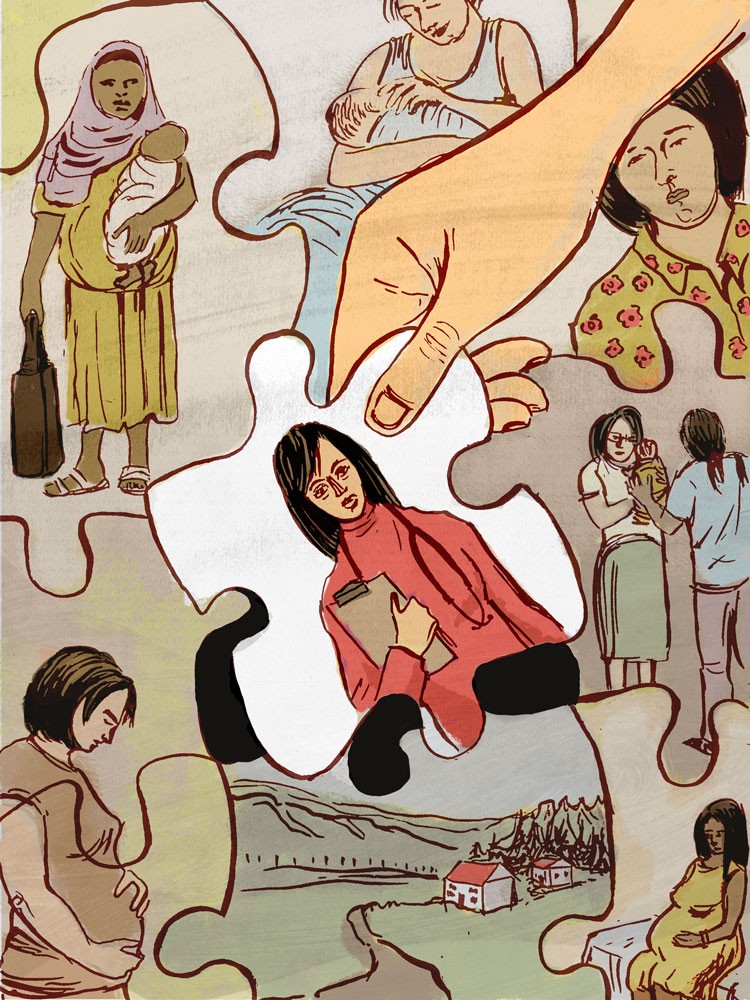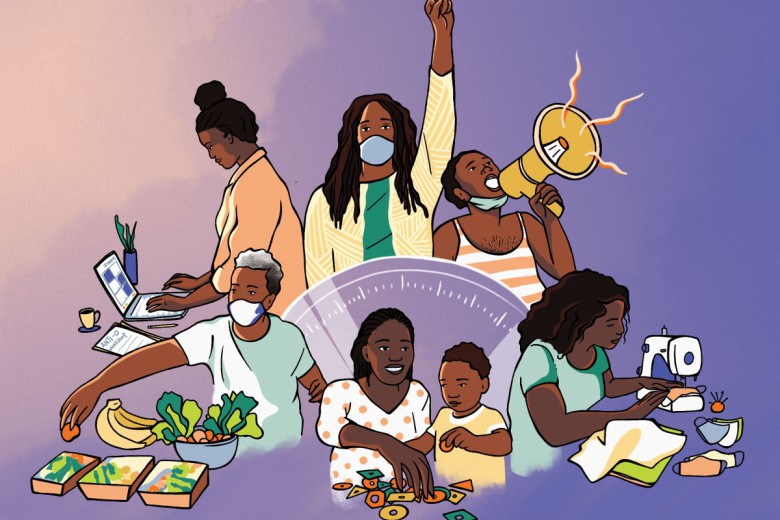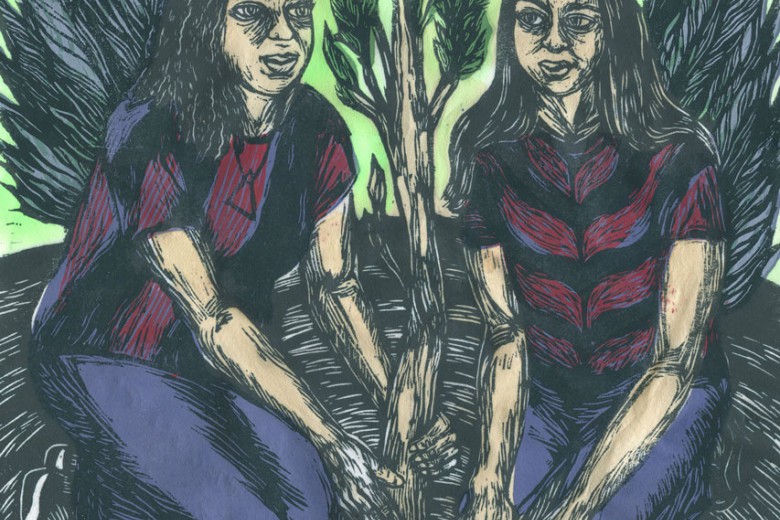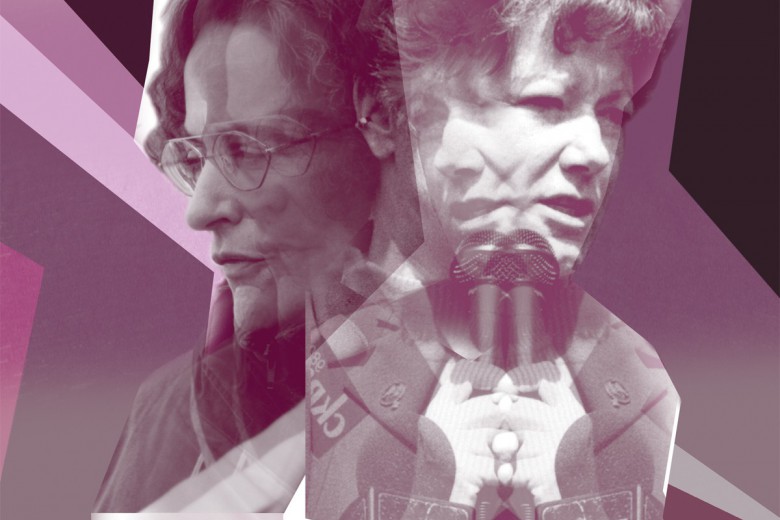
Midwifery, one of the world’s oldest professions, is rapidly becoming a core component of health care delivery to pregnant women in Ontario. Yet an ongoing impasse between midwives and the provincial government over salaries clouds what is an otherwise wildly popular part of the health care system.
In 1994, Ontario was the first jurisdiction in the country to regulate the practice; by 2020, midwives are projected to attend roughly one-quarter of births in the province, an increasing number of which are taking place outside of hospitals.
“Midwives are the only health care providers (HCPs) who are trained and insured to provide care for women choosing to give birth outside of the hospital,” says Lisa Weston, president of the Association of Ontario Midwives (AOM). “Basically, we are the front-line workers for pregnancy and birth and the newborn period.”
Ontario’s midwives are increasingly integrated within the system, taking on more responsibilities and bridging gaps in health care for vulnerable populations of women by attempting to address poverty, immigration status, and access to services in remote areas while enduring gruelling working conditions.
Now, after years of failed negotiations over pay raises, workers in this overwhelmingly female-dominated profession have filed a suit against the province under the Human Rights Code, asserting that Ontario’s 700 midwives are being underpaid by nearly 50 per cent. At a press conference in November 2013 announcing the suit, the AOM characterized midwifery as “systematically neglected.”
A gendered trifecta
The provincial government has rejected this appraisal, maintaining that midwives are adequately compensated. Following the AOM’s announcement, then Health minister Deb Matthews said she was “puzzled” by the suit, pointing to funding increases made under the Liberals, a tune that has not changed since the party’s re-election this year under Premier Kathleen Wynne.
“The Ministry … denies the AOM claim of discrimination against midwives,” said David Jensen, a representative of the Ministry of Health. “Since 2003, compensation for midwives has increased by 33 per cent. In the same time period, annual funding for the midwifery program increased to approximately $125 million, representing more than a 400 per cent increase.”
Midwives say there is a sharp difference between the province’s overall investment in midwifery and midwives’ actual gross income, which ranges from $77,000 to $104,000.
“Their response adds up everything the government pays, including all of [the government’s] operating expenses. Essentially, the government expense of running a midwifery program,” says Weston.
Mary Cornish, a noted pay equity and labour lawyer, is chair of the Equal Pay Coalition. She headed the Ontario Human Rights Code Review Task Force and is representing midwives in the AOM’s court case.
Cornish identifies sexism as the overriding factor in the pay dispute, noting that over 99 per cent of midwives are women.
“It’s a gendered trifecta. Midwives are women, they work for women, and they are engaged in working toward women’s health. Even [accepting] the claim that they make more than the average, they still make way less than their value.”
Barriers to access
Midwives’ importance within the health care system is directly proportional to the cost-effectiveness of the outcomes they achieve. The provincial Midwifery Act insures midwives for services provided from the beginning of pregnancy until six weeks postpartum. Research has indicated that this continuity of care provides significant benefits, including increased breastfeeding rates and reduced instances of emergency medical interventions.
These benefits still come at a cost. The scope of midwifery care, which hinges on 24-7 availability and ever-increasing responsibility, practically guarantees extremely long hours.
According to Weston, the inter-professional tasks midwives perform in order to work effectively with other HCPs is not accounted for in the government’s analysis of their value. “There are committees that you need to be on and meetings that you need to go to. Salaried nurses going to these meetings are getting paid by the hospital while midwives [aren’t].
“The amount of work that midwives do for free is much higher than other professions.”
There are more registered midwives practising in Ontario than in any other jurisdiction in the country. Jensen says that, as a result of Ontario’s investment in the Midwifery Education Program, in the past 10 years the number of women who have access to midwifery services has tripled. In Newfoundland, by contrast, midwifery remains unregulated. In New Brunswick, a lack of public funding means it is impossible for midwives to register.
However, although the situation is worse in other provinces, for many Ontario women, significant barriers to accessing perinatal care still exist.
“Continuity of care is more lacking in rural areas with people who don’t see midwives,” says Amelia Dryden, a midwife working in a midwifery catchment that includes rural areas outside of Kingston.
“The other options for care are going to an obstetrician [until birth and then back to a general practitioner (GP) postpartum] or to a GP until halfway through, then to an obstetrician, then back to a GP.”
Many hospitals also limit how many clients can give birth with midwives as their primary HCP.
“We get a lot of women we can’t accommodate, so we have a campaign going to lift that cap so that women have a choice of HCP,” says Dryden.
According to Weston, caps are a significant problem throughout the province, and the number of available midwives doesn’t begin to meet the demand. “Out of every 10 women who call … four of them can’t get a midwife. We have a limit to what we can provide to ensure the outcomes that we get for women,” she says. “You can’t change that part without changing the whole midwifery model of care.”
Bridging gaps
Besides improving outcomes, midwives also play a role in bridging gaps in primary health care for marginalized populations. One of the largest barriers to access is poverty, particularly for women who lack insurance due to immigration status. Hospitals expect someone with no documentation to personally pay for perinatal care, says Alanna Kibbe, head midwife at Sunnybrook Health Sciences Centre and a partner at Seventh Generation Midwives Toronto, which focuses on Aboriginal midwifery.
“That person would basically be considered a ‘medical visitor,’ ” says Kibbe, noting that Toronto-area hospitals are shutting out medical visitors in an attempt to reduce deficits.
Manavi Handa, a founding partner of West End Midwives in Toronto, works with undocumented women in her practice.
“We’ve come up with a couple of really innovative solutions to provide care for this population. One of them is a partnership with a CHC [community health centre] so that in the case of a consultation or a transfer of care, the CHC will cover the cost and will refer their clients to us and we will care for them,” she says.
Home visits by midwives can help with the isolation faced by those living in poverty or without adequate access to transportation. “It can be really beneficial in the postpartum period because women will feel like they have more support,” says Handa.
Inability to pay for care is not the only barrier. Although hospitals in Ontario don’t call immigration authorities to report undocumented people seeking services, Handa notes that a culture of fear around the possibility of deportation can still prevent them from accessing care.
“People without English as a first language don’t recognize what it means that you can access services without fear, [especially if] someone is treating you with hostility. Showing newcomers you can access health care and not be afraid and treated with dignity … it’s hard to put a compensation value on that. That’s a part of what midwives do.”
Being on call
Without pay equity, Kibbe says many working midwives face a lack of mobility within the profession, with few options for securing alternate sources of income. “That leaves us stuck working hours that would not be considered reasonable in any other profession, hours that residents, and [doctors’] training programs, are being told are too much.”
Midwifery often means working 24 hours at a time for several days a week managing a clinic, attending births, performing home visits, and being on call, which is widely acknowledged as unique to the profession. “If you’re working shifts, you can manage your needs ahead of time. But I never know when I’m going to be sleeping,” says Dryden. In fact, most midwives are on call for all of their clients almost all of the time. By Kibbe’s count, she is off call only six days per month.
In rural areas, midwives travel long distances for home visits. Dryden estimates she drives between two and six hours per day on top of her work. “It makes it harder to take care of the basics in my life. I do get paid [transportation costs], but the time I spend doing it isn’t being adequately compensated.”
Equity
Midwives say their responsibilities have grown to the point where the value of the care they provide is wildly disproportionate to their compensation, especially when considered alongside the pay of other salaried, community-based HCPs.
Originally, midwives’ salaries were based on a pay equity analysis that valued them at 63 per cent that of a CHC physician.
“Our understanding at the time was as [CHC physician] rates increased over the years, the rates of midwifery compensation would also increase, and that has not happened,” says Weston.
An independent analysis included in the lawsuit came up with a relative value per midwife of 91 per cent of a CHC physician. The CHC physician salary maximum in 2013, the year the suit was filed, was $216,000, “and that doesn’t include all of the things that are paid for them,” says Cornish. By this reckoning, equitable pay for midwives would top out at $197,000, which is almost double the current maximum of $104,000.
This analysis is only the latest in a long string of investigations. The most notable of these, commissioned jointly by the Ministry of Health and the AOM, was the 2010 Courtyard report.
Its findings supported the assertions that midwives’ workload had increased beyond that of other obstetrical professions, that they were underpaid compared to CHC physicians and nurse practitioners, and that thousands of women were “denied service due to capacity limits.” The report recommended a one-time pay equity increase of 20 per cent and ongoing negotiations for future raises.
However, the government has since refused to recognize its validity. “The Ministry does not accept the [Courtyard] report’s methodologies and conclusions,” says Jensen. Not long afterward, negotiations stalled, and in 2013 midwives were placed in a compensation freeze.
“Essentially they ignored the Courtyard report, and eventually … the government said we’re not discussing the Courtyard report. That’s when the association retained me,” says Cornish.
Zero for 15 years
The result of the human rights application may be crucial in determining how the profession retains its more experienced workers. “For midwives who are later in life, or who have disabilities … [the] attrition rate is awful,” says Kibbe. “I am the primary income provider for my whole family. I can’t cut back my client load unless I have income replacement. Where am I going to get that? I can’t get another job because I’m on call all the time.”
The more male-dominated group of CHC physicians doesn’t face the same obstacles. For Cornish, the difference in bargaining power between the two professions is at the heart of the issue.
“The doctors’ associations across the country are much more powerful in terms of getting what they want. They are afforded a much better negotiation bias.”
In an age of increasing austerity budgets, midwives complain that years of zero wage increases have been unevenly applied to them in the name of cost-cutting, while there have been regular raises and improvements in working conditions for job classes with larger proportions of men.






